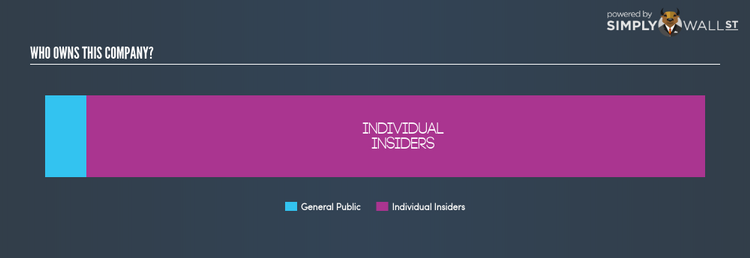What Does Indos SA.’s (WSE:INS) Ownership Structure Look Like?

In this article, I’m going to take a look at Indos SA.’s (WSE:INS) latest ownership structure, a non-fundamental factor which is important, but remains a less discussed subject among investors. The impact of a company’s ownership structure affects both its short- and long-term performance. Since the same amount of capital coming from an activist institution and a passive mutual fund has different implications on corporate governance, it is a useful exercise to deconstruct INS’s shareholder registry.
Check out our latest analysis for Indos
Insider Ownership
Insiders form another group of important ownership types as they manage the company’s operations and decide the best use of capital. Insider ownership has been linked to better alignment between management and shareholders. A major group of owners of INS is individual insiders, sitting with a hefty 93.63% stake in the company. Broadly, insider ownership of this level has been found to negatively affect companies with consistently low PE ratio (underperforming). And a positive impact has been seen on companies with a high PE ratio (outperforming). Another aspect of insider ownership is to learn about their recent transactions. Insider buying may be a sign of upbeat future expectations, however, selling doesn’t necessarily mean the opposite as insiders may be motivated by their personal financial needs.
General Public Ownership
With 6.37% ownership, the general public are also an important ownership class in INS. While this size of ownership may not be enough to sway a policy decision in their favour, they can still make a collective impact on company policies if it aligns with other large shareholders.
Next Steps:
A relatively significant holding of company insiders could mean high alignment with shareholders. But at the same time, investors should be aware of the level of influence executives could have on governance decisions. However, ownership structure should not be the only focus of your research when constructing an investment thesis around INS. Instead, you should be evaluating company-specific factors such as the intrinsic valuation, which is a key driver of Indos’s share price. I highly recommend you to complete your research by taking a look at the following:
1. Financial Health: Is INS’s operations financially sustainable? Balance sheets can be hard to analyze, which is why we’ve done it for you. Check out our financial health checks here.
2. Past Track Record: Has INS been consistently performing well irrespective of the ups and downs in the market? Go into more detail in the past performance analysis and take a look at the free visual representations of INS’s historicals for more clarity.
3. Other High-Performing Stocks: Are there other stocks that provide better prospects with proven track records? Explore our free list of these great stocks here.
NB: Figures in this article are calculated using data from the last twelve months, which refer to the 12-month period ending on the last date of the month the financial statement is dated. This may not be consistent with full year annual report figures.
To help readers see pass the short term volatility of the financial market, we aim to bring you a long-term focused research analysis purely driven by fundamental data. Note that our analysis does not factor in the latest price sensitive company announcements.
The author is an independent contributor and at the time of publication had no position in the stocks mentioned.

